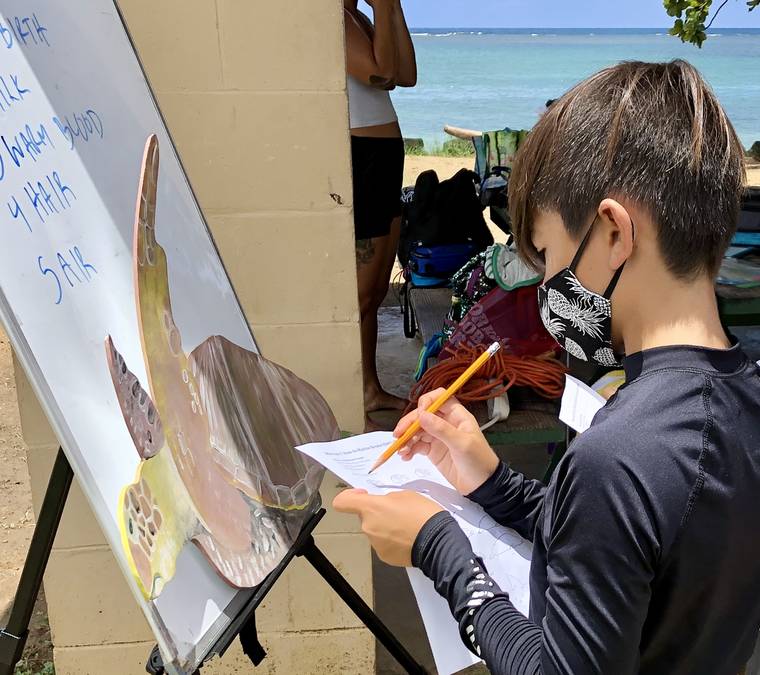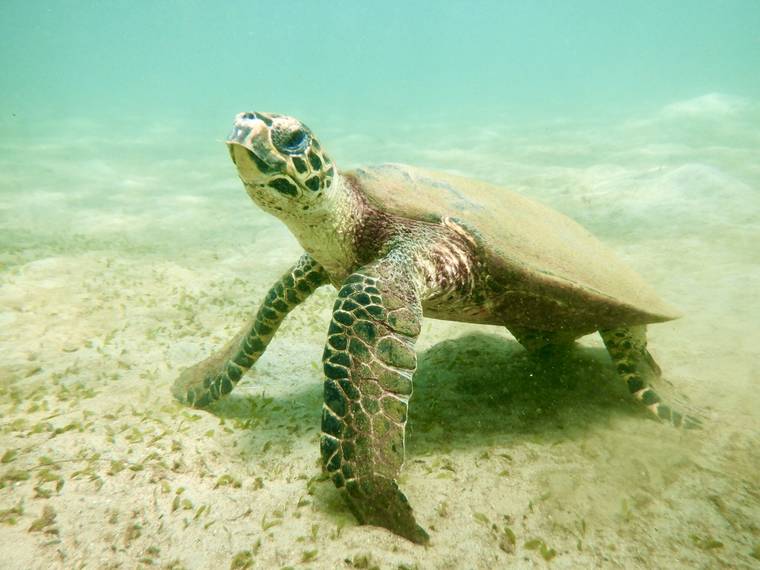‘ANINI — On a warm, sunny day at ‘Anini Beach just prior to Hurricane Douglas, participants at Reef Guardians Coral Reef Kids Camp made an exciting discovery.
Snorkeling their way back toward shore after an already intriguing dive, Reef Camp teacher Briana Smith and her “pod” of young explorers came upon a sea turtle that caught their attention. The group had been studying Hawaiian green sea turtles, and something looked different about this turtle.
“I noticed its protruding, beak-like mouth and was struck with excitement,” said Smith. “I knew we had made a rare discovery.”
The turtle is a hawksbill, honu‘ea, a species rarely seen though native to Hawai‘i.
“I explained to the children that there are very few hawksbill turtles discovered in Hawai‘i, which is why we needed to make good documentation of its freckles so it can later be identified,” Smith said.
The reef campers knew what their teacher meant.
The previous day’s science class introduced data-collection and how researchers photograph certain areas of an animal’s body to be able to identify each individual.
The students had already practiced capturing and comparing images using cameras to snap pictures of large model animals. For whales, it’s the color, shape and scars on their flukes. Scar patterns are tracked on monk seals. For sea turtles, it’s the markings on the sides of their heads.
In the water, when they spotted the turtle, the snorkelers acted quickly. Camper Sawyer Kimball loaned Smith his underwater camera. The pictures were then sent to the Hawaiian Hawksbill Conservation organization, hihawksbills.org.
“I let the children know if this was a hawksbill that had not been discovered yet, we would get to name it. Little did I know this was about to be the case,” Smith said.
“Word came a few days later from Cheryl King at Hawai‘i Hawksbill declaring that it’s a new individual to the catalog, #KI24, and we would be able to name it,” said Reef Guardians Director Robin Mazor, who also saw the hawksbill turtle along with her pod of young snorkelers that day.
Because Smith was the first person to lay eyes on the hawksbill, she was asked if she wanted to name the turtle. But she decided to share that honor.
“If it wasn’t for Reef Guardians or my pod, I wouldn’t have been there to see the turtle in the first place. So, we came up with the idea to have a naming contest,” Smith said.
Here is a list of the proposed names and their meanings:
• Apapa Kia‘i — “Reef guardian” in Hawaiian;
• Breezy — Briana Smith’s nickname;
• E ho‘okau maika‘i — “To cause good fortune” in Hawaiian;
• Ha — “Breath” in Hawaiian
• Sawyer — The name of the student who loaned Smith the camera.
Instead of just opening up the naming of the 24th hawksbill turtle to be found on Kaua‘i to Reef Guardians’ students, the organization is asking help from the entire Kaua‘i community.
To vote on a name for the newly identified turtle, visit reefguardians.org and click the “Vote for Hawksbill” button. You can also reach the Vote button through Reef Guardians Hawai‘i on Facebook or reef.guardians on Instagram.
Hawksbill turtles are endangered and protected under the federal Endangered Species Act. They are smaller than green sea turtles, and have a unique beak and beautiful shell.
“Through the informal outdoor educational nature of Reef Camp, we are able to share meaningful and memorable experiences like the honu‘ea (hawksbill) encounter that can happen on any day,” said Mazor, often called “Ms. Mermaid” by her students.
“While times are rough for people of all ages, we are so grateful to be able to teach marine science, art and stewardship to curious and caring young people. Coming from all parts of Kaua‘i, these children are sincerely connected to the ocean, its inhabitants and its future.”
Reef Camp is a program of Reef Guardians Hawai‘i, a 501(c)(3) nonprofit organization whose mission is reef preservation through research, restoration and education.







Sawyer